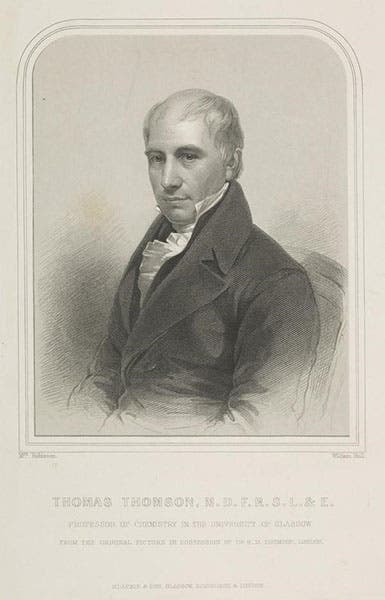Scientist of the Day - Thomas Thomson
Thomas Thomson, a Scottish chemist, was born Apr. 12, 1773. There were many significant chemists working in this era �– Jons Berzelius, John Dalton, Amedeo Avogadro, Joseph Gay-Lussac, Joseph Proust, William Wollaston, Humphry Davy – and Thomson is undoubtedly the one you have never heard of. But he was probably just as important as anyone else in disseminating the new chemistry coming out of France and flourishing in England and Scotland. He wrote several textbooks, the most influential being A System of Chemistry (1802), of which we have the third edition (1807) and a French translation (1812). In these works, and in their later editions, he promoted the work of John Dalton, for example, and made it more widely known.
Perhaps Thomson’s most valuable contribution to chemistry was to found and edit a new chemical journal, with the unwieldy title: Annals of Philosophy, or, Magazine of chemistry, mineralogy, mechanics, natural history, agriculture, and the arts. Thomson saw it through 8 years and 16 volumes; we have the complete set in our serials collection. Many important announcements were made in its pages, and discoveries presented, the most famous perhaps being an anonymous paper by William Prout in volume 6 (1815; third image), where Prout argued that since the atomic weights of most elements are simple multiples of that of hydrogen, then probably all the elements are built up from hydrogen atoms, which thus becomes the fundamental chemical unit. Once the authorship was revealed, this became known as “Prout’s hypothesis”, which was quite influential for a while, then went into eclipse when some elements, such as chlorine, were discovered to have half-integral atomic weights, and then had another short spurt of popularity when isotopes were discovered in the early 20th century, explaining the mysterious atomic weight of chlorine.
Thomson's own small contribution to the organization of chemistry was to rename "silicon." The name then used was silicium, and Thomson pointed out that it was not at all like the other "-ium" metals, but more like carbon and boron, and so should have a name – silicon – that indicates that family resemblance. His suggestion was almost immediately adopted.
Thomson made the news in unusual fashion in 2018, when it was discovered that his features were to be found on one of the bronze participants in a group sculpture in Saint Petersburg, Russia (fourth image). Sculptor Alexander Taratynov had been commissioned in 2011 to create a life-size grouping of the various architects who created Saint Petersburg. One of those was the French architect, Thomas de Thomon. Taratynov looked him up on Wikipedia, and used that image for his figure, but it turned out that Wikipedia had used an engraving of Thomson the chemist for Thomon the architect (fifth image). Taratynov blamed Wikipedia, when he should have blamed himself for shoddy research, but the Scots got quite a chuckle out of it, and still do. And historians of chemistry now have something to look for when they take a walking tour of Saint Petersburg.
William B. Ashworth, Jr., Consultant for the History of Science, Linda Hall Library and Associate Professor emeritus, Department of History, University of Missouri-Kansas City. Comments or corrections are welcome; please direct to ashworthw@umkc.edu.




![First page, “On the relation between the specific gravities of bodies in their gaseous state and the weights of their atoms,” by [William Prout], first enunciation of “Prout’s hypothesis,” Annals of Philosophy, vol. 7, 1815 (Linda Hall Library)](https://assets-us-01.kc-usercontent.com:443/9dd25524-761a-000d-d79f-86a5086d4774/a8eed1cb-9e73-4aeb-88ff-1a29f5315ca1/thomson3.jpg?w=518&h=600&auto=format&q=75&fit=crop)






